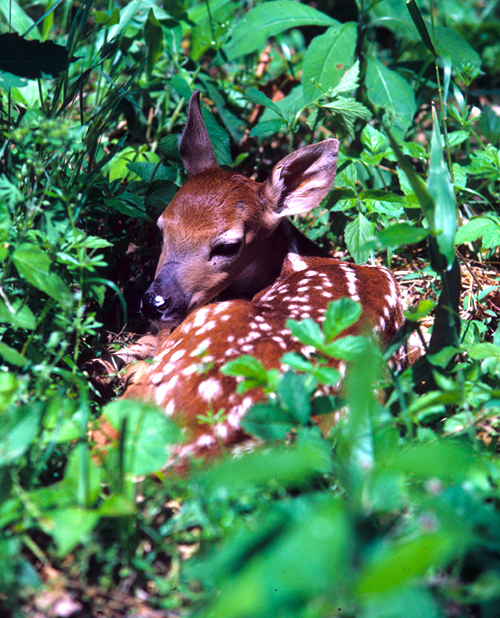By Art Lander Jr
FRANKFORT, Ky. – When someone finds a deer fawn curled up in high grass or hiding beneath the shrubbery of a home at the edge of the woods, it’s often assumed that the fawn is abandoned.
But David Yancy, a deer biologist for the Kentucky Department of Fish and Wildlife Resources, explained that mother deer don’t abandon their newborns.

“The mother leaves the fawn often for hours at a time, between morning and evening nursing,” said Yancy. “The doe stays away from the fawn because she doesn’t want to attract attention to it. While she’s away from her fawn she feeds and rests.”
Fawns are scentless at birth, and hide in grass and weeds, their spots helping to camouflage them.
If the mother deer feels threatened by the approach of a human or a predator, she moves off, so the threatening presence will follow her and not endanger her fawn.
Newborn deer remain bedded for the first few weeks of life until they are strong enough to run at their mother’s side to escape predators.
The doe is never far from her fawn. “The mother is likely in some nearby woods. She’s definitely within earshot and will usually come running if the fawn bleats,” said Yancy.
Landowners are asked to leave deer fawns alone if they encounter one. “If you find one while mowing your hay field, pick it up and put it somewhere nearby where you won’t be mowing. The mother will return and find it in the evening,” said Yancy.
The gestation period for white-tailed deer is about 200 days. Female deer bred in November drop their fawns in the period from late May to early July. The peak of births occurs in mid-June, prompting an increase in calls to the information center at the Kentucky Department of Fish and Wildlife Resources.
“Callers don’t know what to do with the seemingly abandoned young deer. They don’t realize the fawn has not been abandoned at all,” said Yancy. “Some people who don’t know better will pick them up.”
The worst thing you can do is to pick up the fawn and try to raise it on your own. Humans are poor substitutes for the fawn’s natural mother.
“It always ends badly for either the human or the deer,” Yancy said. “It is also illegal. The only people who can have deer in captivity are rehabilitators or someone with a captive cervid permit.”
The cute baby deer that weighs 6 to 8 pounds in June will grow to 65 to 75 pounds by that fall and 125 pounds by the following summer. “By the next fall, the male deer are sexually mature,” Yancy said. “They can hurt you. They start tearing up things, eating gardens and exhibiting other destructive behavior. They can seriously injure a person with their antlers and hooves. They are going to try to show you that they are dominant.”
The best thing a person can do if they encounter a baby deer on their property is to leave the fawn alone. Mother Nature will take care of young deer much better than humans can.
Media Contact: Art Lander Jr 1-800-858-1549, ext. 4414


I know many people who enjoying deer hunting. I dislike it. I think,they are the prettiest animals on this earth. They mind their own business. There are other sports to enjoy!!